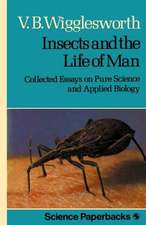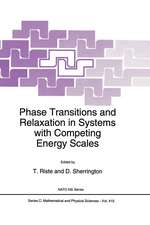Electron-Phonon Interactions and Phase Transitions: NATO Science Series B:, cartea 29
Editat de T. Risteen Limba Engleză Paperback – 31 mai 2013
Din seria NATO Science Series B:
- 5%
 Preț: 375.70 lei
Preț: 375.70 lei - 5%
 Preț: 369.29 lei
Preț: 369.29 lei - 5%
 Preț: 720.84 lei
Preț: 720.84 lei - 18%
 Preț: 1406.03 lei
Preț: 1406.03 lei - 5%
 Preț: 373.33 lei
Preț: 373.33 lei - 5%
 Preț: 723.78 lei
Preț: 723.78 lei -
 Preț: 391.79 lei
Preț: 391.79 lei - 5%
 Preț: 1445.00 lei
Preț: 1445.00 lei - 5%
 Preț: 380.61 lei
Preț: 380.61 lei - 5%
 Preț: 1103.75 lei
Preț: 1103.75 lei - 5%
 Preț: 711.72 lei
Preț: 711.72 lei - 5%
 Preț: 1414.08 lei
Preț: 1414.08 lei - 18%
 Preț: 957.44 lei
Preț: 957.44 lei - 5%
 Preț: 723.21 lei
Preț: 723.21 lei - 5%
 Preț: 727.44 lei
Preț: 727.44 lei - 5%
 Preț: 1117.46 lei
Preț: 1117.46 lei - 5%
 Preț: 1429.80 lei
Preț: 1429.80 lei - 5%
 Preț: 366.56 lei
Preț: 366.56 lei - 5%
 Preț: 1116.21 lei
Preț: 1116.21 lei - 5%
 Preț: 1106.33 lei
Preț: 1106.33 lei - 5%
 Preț: 1107.77 lei
Preț: 1107.77 lei - 5%
 Preț: 1098.48 lei
Preț: 1098.48 lei - 5%
 Preț: 715.71 lei
Preț: 715.71 lei - 5%
 Preț: 1428.71 lei
Preț: 1428.71 lei - 5%
 Preț: 2004.54 lei
Preț: 2004.54 lei - 5%
 Preț: 724.70 lei
Preț: 724.70 lei - 5%
 Preț: 1438.38 lei
Preț: 1438.38 lei - 5%
 Preț: 1109.23 lei
Preț: 1109.23 lei - 5%
 Preț: 1414.64 lei
Preț: 1414.64 lei - 5%
 Preț: 1291.01 lei
Preț: 1291.01 lei - 5%
 Preț: 1029.50 lei
Preț: 1029.50 lei - 5%
 Preț: 388.12 lei
Preț: 388.12 lei - 5%
 Preț: 1104.48 lei
Preț: 1104.48 lei -
 Preț: 383.93 lei
Preț: 383.93 lei - 5%
 Preț: 718.46 lei
Preț: 718.46 lei - 5%
 Preț: 1113.63 lei
Preț: 1113.63 lei - 5%
 Preț: 369.45 lei
Preț: 369.45 lei - 5%
 Preț: 1108.72 lei
Preț: 1108.72 lei - 5%
 Preț: 1107.77 lei
Preț: 1107.77 lei - 5%
 Preț: 1297.99 lei
Preț: 1297.99 lei - 5%
 Preț: 1123.87 lei
Preț: 1123.87 lei - 5%
 Preț: 718.65 lei
Preț: 718.65 lei - 5%
 Preț: 1954.62 lei
Preț: 1954.62 lei - 5%
 Preț: 721.40 lei
Preț: 721.40 lei
Preț: 402.38 lei
Nou
Puncte Express: 604
Preț estimativ în valută:
76.100€ • 80.59$ • 64.08£
76.100€ • 80.59$ • 64.08£
Carte tipărită la comandă
Livrare economică 31 martie-14 aprilie
Preluare comenzi: 021 569.72.76
Specificații
ISBN-13: 9781461589235
ISBN-10: 1461589231
Pagini: 436
Ilustrații: XV, 416 p. 8 illus.
Dimensiuni: 178 x 254 x 23 mm
Greutate: 0.75 kg
Ediția:Softcover reprint of the original 1st ed. 1977
Editura: Springer Us
Colecția Springer
Seria NATO Science Series B:
Locul publicării:New York, NY, United States
ISBN-10: 1461589231
Pagini: 436
Ilustrații: XV, 416 p. 8 illus.
Dimensiuni: 178 x 254 x 23 mm
Greutate: 0.75 kg
Ediția:Softcover reprint of the original 1st ed. 1977
Editura: Springer Us
Colecția Springer
Seria NATO Science Series B:
Locul publicării:New York, NY, United States
Public țintă
ResearchCuprins
Phase Transitions and Electron-Phonon Couplings in Perfect Crystals. Modulated Structures. An Introduction.- I. The Framework.- II. Electron-Phonon Couplings (for Delocalized Electrons).- Appendix A. Short Range Order due to Dispersion Forces.- Appendix B. LCAO Studies of the Band Structures of Metals and Covalents.- Appendix C. Phase Stability for Nearly Free Electrons.- Appendix D. Cohesion in Transitional Metals.- Neutron Scattering Studies of Electron-Phonon Interactions.- I. Phonon Dispersion in Metals.- II. Kohn Singularities.- III. Neutron Spectroscopy of Superconductors.- IV. Magnetic Field Effects.- V. Charge Density Wave Instabilities.- Phase Transitions in Quasi One-Dimensional Metals (TTF-TCNQ and KCP).- 1. Introduction.- 2. Interchain Coupling.- 3. Landau-Ginzburg Theory of Structural Phase Transformations and Charge Density Waves in TTF-TCNQ.- 4. Impurities.- Solitons and Charge Density Waves.- 1. Abstract.- 2. Introduction.- 3. Change Density Waves and the Sine-Gordon Equation.- 4. Solitons and Charge Density Waves.- 5. Solitons in Disordered Systems.- 6. Classical Solitons in Two Dimension.- 7. Three Dimensional Ordering.- Charge Density Waves in Layered Compounds.- Landau Theory of the Charge Density Waves.- A. The Landau Free Energy.- B. Phase Transitions.- C. Fluctuation Modes.- D. Impurity Effects l.- E. CDW Dislocations l.- F. Discommensurations.- Microscopic Model of CDW in 2H-TaSe2.- Light Scattering by Charge Density Wave Modes in KCP and 2H-TaSe2.- Symmetry Classification of Modulated Structures.- 1. Definition of Modulated Structures.- 2. Symmetry Operations and -Translations.- 3. Properties of MS-Space Group Operations.- 4. Reduced Form of Point Group Operations.- 5. Equivalence and Invariance of k-vectors.- 6. Point Groups.- 7. Rational and Irrational Non-Zero Components of k l.- 8. Necessity of Introduction of Bravais Lattice Types with Improper Translations.- 9. Two-Dimensional Example of Improper Translations.- 10. Enumeration of Lattice Types.- Superspace Groups for the Classification of Modulated Crystals.- I. Introduction.- II. Superspace Groups.- III. Equivalence Classes.- IV. Examples.- V. Conclusions.- Structural Phase Transitions and Superconductivity in A-15 Compounds.- I. Introduction.- II. Instabilities and Transformation Effects on the Physical Behaviour.- III. More on the Relation of Structural Instability and High Temperature Superconductivity.- IV. Instabilities, Unstable Phases, and Superconductivity.- V. Defects, Instabilities, and Superconductivity.- Superconductivity and Martensitic Transformations in A-15 Compounds.- p-d Hybridization, Incipient Lattice Instabilities and Superconductivity in Transition METAL Compounds.- Pseudo-Spin Approach to Structural Phase Transitions.- Abstract.- 1. Introduction.- 2. Models.- 3. Properties of Models.- 4. Mixed and Dilute Systems.- 5. The Central Peak; Critical Behaviour.- Theory of Jahn-Teller Transitions.- 1. Introduction.- 2. Dynamics of JT-Systems.- 3. Specific Cases.- Local Jahn-Teller Effect at a Structural Phase Transition.- Abstract.- 1. Introduction.- 2. Multimode JT-Effect.- 3. Critical Enhancement.- Optical Studies of Jahn-Teller Transitions.- 1. Introduction.- 2. 3d-Transition Metal Ions.- 3. Cooperative Jahn-Teller Effects in Rare-Earth Crystals.- 4. Optical Studies of Complicated Jahn-Teller Transitions.- 5. Conclusion.- Electric Susceptibility Studies of Cooperative Jahn-Teller Ordering in Rare-Earth CRYSTALS.- Neutron Scattering Studies of the Cooperative Jahn-Teller Effect.- Abstract.- 1. Introduction.- 2. The Neutron Probe.- 3. Symmetries and Crystal Fields.- 4. Theory.- 5. Static and Critical Properties.- 6. Normal and Mixed Modes.- 7. Discussion 3l.- Gamma-Ray Diffraction Studies of the Mosaic Distribution in TmAsO4 Near the Cooperative Jahn-Teller Transition at 6 K.- The Central Peak in TbVO4.- The Nature of the Eigenfunctions in a Strongly Coupled Jahn-Teller Problem.- I. Introduction.- II. The Physical Setting.- III. The Hamiltonian.- IV. Absorption Spectrum.- V. Summary and Conclusions.- Cooperative Pseudo Jahn-Teller Model of the Sequence of Ferroelastic Transitions in Barium Sodium Niobate.- Single Ion and Cooperative Jahn-Teller Effect for a Nearly Degenerate E Doublet.- Abstract.- 1. Physical System and Model.- 2. Calculations, Results and Discussion.- 3. Conclusions.- Study of the Mott Transition in n.Type CdS by Spin Flip Raman Scattering and Faraday Rotation.- I. Introduction.- II. Basic Properties of Cadmium Sulfide.- III. Spin Flip Scattering.- IV. Study of the SFRS Linewidth.- V. Measurement of X0 Rotation.- VI. Discussion of Results.- Electron Phonon Interactions and Charge Ordering in Insulators.- I. Charge Ordering in Insulators.- II. Second Grade Ordering: Jahn-Teller Ordering in K2PbCu(NO2)6..- III. Zeroth Grade Ordering in Fe3O4.- The Verwey Transition in Magnetite.- I. Introduction.- II. Crystal and Symmetry.- III. Critical Scattering.- IV. Structure below TV.- Participants.















